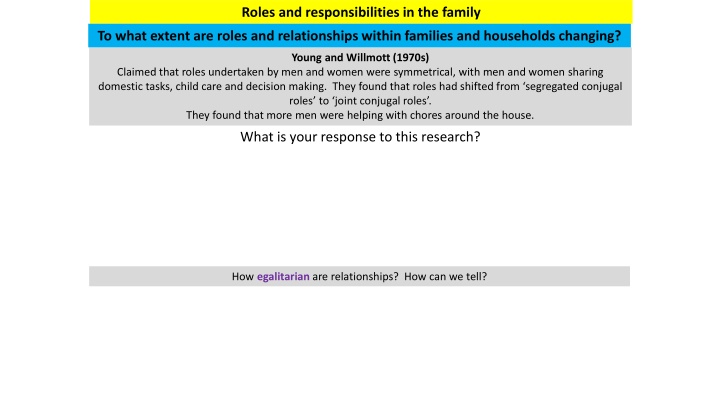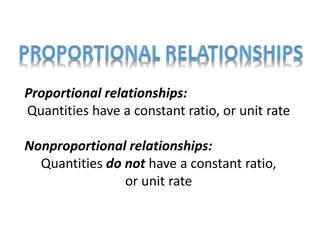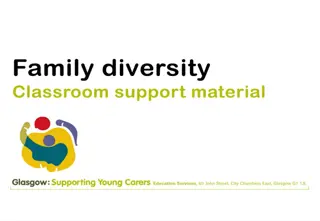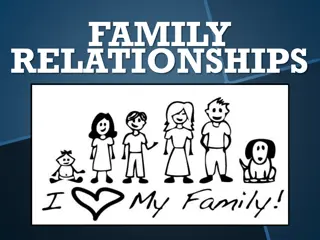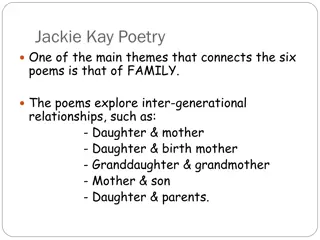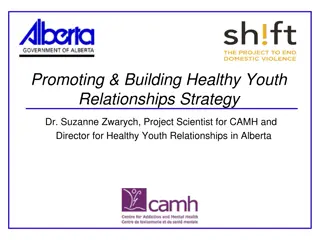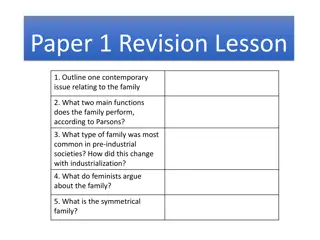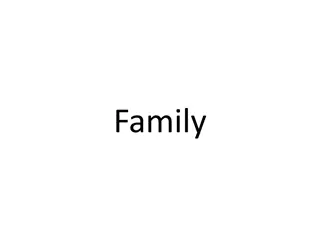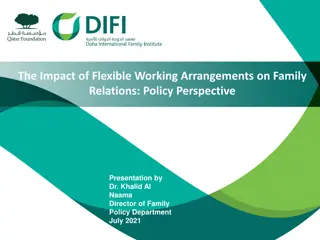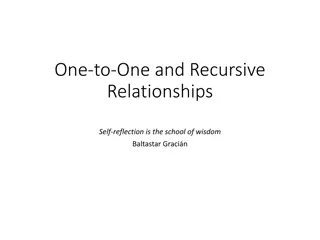Changing Family Roles and Relationships: A Modern Perspective
The dynamics of family roles and responsibilities have evolved over time, transitioning from traditional gendered divisions to more egalitarian arrangements. Research suggests a shift towards joint conjugal roles, with men increasingly participating in domestic chores and childcare duties. Explore the changing landscape of family dynamics and the implications of more balanced relationships within households.
Download Presentation

Please find below an Image/Link to download the presentation.
The content on the website is provided AS IS for your information and personal use only. It may not be sold, licensed, or shared on other websites without obtaining consent from the author.If you encounter any issues during the download, it is possible that the publisher has removed the file from their server.
You are allowed to download the files provided on this website for personal or commercial use, subject to the condition that they are used lawfully. All files are the property of their respective owners.
The content on the website is provided AS IS for your information and personal use only. It may not be sold, licensed, or shared on other websites without obtaining consent from the author.
E N D
Presentation Transcript
Roles and responsibilities in the family To what extent are roles and relationships within families and households changing? Young and Willmott (1970s) Claimed that roles undertaken by men and women were symmetrical, with men and women sharing domestic tasks, child care and decision making. They found that roles had shifted from segregated conjugal roles to joint conjugal roles . They found that more men were helping with chores around the house. What is your response to this research? How egalitarian are relationships? How can we tell?
Are relationships becoming more egalitarian? Use the information on pages 96-100 of the textbook. Summarise the theoretical perspectives on relationships between partners.
Are relationships becoming more egalitarian? Use the information on pages 96-100 of the textbook. Summarise the theoretical perspectives on relationships between partners.
Are relationships becoming more egalitarian? Use the information on pages 96-100 of the textbook. Summarise the theoretical perspectives on relationships between partners.
Domestic Roles Who always / usually undertakes tasks Who always / usually undertakes tasks Does the laundry Does the household cleaning Always / usually men Always / usually men Both Equally Both Equally Always / usually women Always / usually women Makes small repairs around home Prepares the meals Always / usually men Always / usually men Both equally Both equally Always / usually women Always / usually women Cares for sick family members Responsible for childcare arrangements. Always / usually men Always / usually men Both equally Both equally Always / usually women Always / usually women Shops for groceries Always / usually men Both equally Always / usually women
To what extent are roles and relationships within families and households changing? Domestic Roles
To what extent are roles and relationships within families and households changing? Domestic Roles
To what extent are roles and relationships within families and households changing? Decision making:
To what extent are roles and relationships within families and households changing? Preference theory:
Roles and responsibilities: Parents and children How would you define childhood?
Roles and responsibilities: Parents and children Philippe Aries (1960) Philippe Aries is a historian and he argued that in the middle ages, the idea of childhood did not exist . Children were weaned, however once they were passed the stage of being physically dependent on the parents, they were seen to be adults. Children began work at a very early age , they were seen as mini-adults with the same rights, duties and skills as adults. For example the law often made no distinction between children and adults with children facing severe punishments. Edward Shorter (1975) argued that parental attitudes towards children was also very different - high death rates encouraged indifference and neglect. Often, children were called it or forgotten about. Aries looked at various evidence to illustrate his points e.g. used works of art from this period In these paintings he argued that children appeared without any of the characteristics of childhood , they were simply shown on a smaller scale. These paintings showed children and adults dressed in the same clothing and working and playing together. He argued that parts of the modern idea of childhood came about after the 13th century.
Why did modern childhood come about? There are many reasons why the modern idea of childhood came about. These are some of them Industrialisation society now needs an educated workforce Child protection acts (1989 Children Act) Laws restricting child labour Laws that apply specifically to children i.e. Age of consent is 16 Reasons for the development of modern childhood Development of economic market directed at childhood Introduction of compulsory education
To what extent are roles and relationships between parents and children are changing? The impact of the state Read the information on the previous page: How has the state become more involved in the lives of parents and children? What impact has this had on the relationships between parents and children?
To what extent are roles and relationships between parents and children are changing? Postman argues that childhood is disappearing. His view is based on two related ideas. 1. The growth of television means that there are no more secrets from children. Television gives them unlimited access to the adult world. They are exposed to the real world of sex, disaster, death and suffering. 2. Social blurring has occurred so there is little distinction between adults and children. Children s games are disappearing and children seem less childlike today. They speak, dress and behave in more adult ways while adults have enjoyed looking more like kids and youth generally. Over time, nearly all the traditional features that mark the transition to adulthood getting a job, religious confirmation, leaving home, getting married, no longer apply in any clear way. Postman s analysis has been heavily criticised. His arguments do not appear to be based on solid evidence, while recent studies indicate that adults are actually taking more and more control of their children s lives. For example David Brooks (2001) diagnoses parents today as obsessed with safety, and ever more concerned with defining boundaries for their kids and widening their control and safety net around them. Perhaps it is children that are disappearing rather than childhood. Children are a smaller percentage or our overall population toy and are diminishing in relative proportion to other age groups.
To what extent do you believe that childhood is disappearing Use the information on page 138-139 of your handout to help you. Childhood is disappearing Childhood is not disappearing Conclusion
To what extent are roles and relationships between parents and children are changing? The role of mothers Pages 106-107 Explain how the role of mothers has changed
To what extent are roles and relationships between parents and children are changing? The role of fathers Pages 108-109 and study on page 110 of textbook - Explain how the role of fathers has changed
To what extent are roles and relationships between parents and children are changing? The role of grandparents Pages 109-110 Explain how the role of grandparents has changed
The dark side of family life: Functionalist: Marxist: Marxist-Feminist Radical-Feminist Psychological explanation Liberal Feminist Postmodern-Feminist
Elisabeth Stanko - Measuring Domestic Violence 1 in 4 women and 1 in 7 men report a physical assault by a partner during their lifetime. Around 10% of women experience domestic violence in any given year. The form of violence is largely male offenders against female victims 1 incidence of domestic violence is reported by women to the police every minute in the UK Some sociologists have reported increases in female violence against men, but it is estimated that this only constitutes 5% of all domestic violence. Nazroo found that wives often live in fear of men s potential violence of threats, whilst husbands rarely feel frightened or intimidated by their wives potential for violence. Feminists Approaches to Domestic Violence Feminists suggest that domestic violence is a problem of patriarchy. They suggest that domestic violence arises from two sources: Different gender role socialisation Boys are socialised into masculine values, which revolve around risk-taking, toughness, aggression and so on. Many boys / men are brought up to believe that they should have economic and social power as breadwinners. Socialisation into femininity, involves learning to be passive and subordinate, which may be one reason why women tolerate violence. A crisis in masculinity Men s traditional source of identity, i.e. work, is no longer guaranteed. Working women and unemployment have challenged men s status as heads of households. Women may be demanding more authority in the home and insisting that unemployed men play a greater domestic role some men see this as threatening their masculinity. Violence Reflects Individual Pathology / Personality This model assumes that there are significant differences between abnormal men who abuse their partners and normal men who don t. Dobash and Dobash suggested that abusive men tended to have insecure childhoods. Psychodynamic theories lend some support to this model. They suggest that some children are socialised to become interdependent and to deny their vulnerable feelings: in this way, men can come to fear dependency and may lash out aggressively if they are reminded of their own needs and vulnerabilities. Sociologists say that it is important not to individualise the problem of domestic violence and to take into account the influence that society and cultural have on patterns of violence. Therefore, violence may be an aspect of the anxiety men are feeling about their economic and domestic role. Feminists argue that as long as men have the capacity to commit such violence, there can never be inequality within a marriage/cohabiting couple.
Domestic violence: Why might it be difficult to collect data about domestic violence? What ethical issues may be associated with the study of domestic violence? What are the similarities and differences between the Feminist explanation of domestic violence and the psychodynamic approach?
The dark side of family life: Child abuse Image result for xhosa circumcision age Through western eyes the Xhosa practice might be seen as child abuse, however in some societies (including the Xhosa) Western practices such as isolating infants and small children in rooms or beds of their own and feeding them at specific times rather than when they re hungry may well be seen as child abuse (Adapted from Korbin, 1981) The Xhosa initiation ritual which boys go through to become men. They usually undertake this ritual between the ages of 13 and 16. Use this information to explain what is meant by the statement child abuse is culturally defined .
Child abuse: Sociologists have identified four categories of abuse: Physical Neglect Emotional Sexual Cases of abuse are reported by the public, the police, social workers, teachers and others. These cases are then investigated by social workers who have to decide whether or not the children are put on a child protection register. There are two problems with this register: a number of cases aren't reported. It reflects the concerns and priorities of governments, local authorities and the public e.g. in 1978, very little was known about sexual abuse - it wasn't considered to be an official or a public issue. By the mid 1980s, priorities had changed and reports of sexual abuse soared. There are no in-depth studies available to look at the scope of physical abuse in the UK. There are some studies of physical punishment inflicted on children e.g. Newson and Newson (1989) found in a longitudinal study of 700 families in Nottingham, that 41% of 7 year olds were hit at least once a week, and that 22% of mothers used several things such as straps, canes and slippers. What is the gender, social position and family situation of child abusers? Gender - An analysis of cases of abuse reported between 1983 and 1987 shows that fathers were involved in 61% of cases, and mothers in 36% of cases. Mothers are more likely of being involved in neglect and emotional abuse. (Creighton and Noyes). Men are much more likely to abuse sexually. In a survey of children who had been sexually abused at Great Ormond Street Hospital between 1980 and 1986, only 8 out of 411 had been sexually abused by a woman. (Ben-Tovin et al. 1988) Poverty - People who physically abuse children are concentrated in low-income groups. Statistics by the Department of Health (1995) show that 95% of children on the child protection register come from families living in poverty. Is there a link between poverty and child abuse, or are they more likely of being caught because of their involvement with social services? (Corby, 2000). Survey data states that sexual abuse is widespread across these social groups. However, in a study by Great Ormond Street, 92% cases of sexual abuse had come from manual working class backgrounds. This might reflect involvement with social services who are more likely to discover abuse in these families than in others. Family Structure - Official statistics suggest that children from one-parent families are more at risk of all forms of abuse. One-parent families are more likely to live in poverty, and to be involved with social services. Children from reconstituted families are also at greater risk of being abused. However, this cannot be a result of the family situation. Problems with the evidence: Taylor is critical of the research methods used to collect information on child abuse. He points out that information gathered is based on official statistics collected by the Home Office or organisations such as Childline or from victim surveys
Explanations of Child Abuse The Disease Model This model assumes that child abuse is the product of illness or abnormality a defect in the personality/character of parents. This approach is similar to the media images of child abusers. It sees child abuse as the product of unusual family circumstances. The Functionalist / New Right Theory Vogel and Bell maintain that the dysfunction of child abuse may be a lesser evil than the breakdown of the family. They are focussing on emotional abuse where the child is used as an emotional weapon by the feuding parents. From this perspective, such emotional abuse may be preferable to divorce, with all its attendant problems. Structural Theories Parton is critical of both the above models as they suggest that child abuse is only found in extreme cases. He argues that it is more routine than society likes to admit. The models above give the impression that only certain sections of society one parent families and those in poverty are likely to commit child abuse. He argues that they fail to consider that affluence may disguise child abuse it may be just as common in middle class households. Parton argues that structural circumstances in which people live can put great strain on personal relationships. For example at the lower end of the economic scale, it may be the stress of poverty, unemployment, debts and marital problems that may lead to abuse. Middle-class abuse may be due to lack of job satisfaction, financial anxieties and fear of redundancy. Feminist Theories This perspective mainly focuses on sexual child abuse, which is mainly seen as a symptom of male power in a patriarchal society. Feminists suggest that sexual abuse is the product of society where males are socialised into seeing themselves as sexually dominant and into sexually objectifying females. Some men in the family may sexually objectify both wife and daughters and view them as sexual property to be exploited. They do acknowledge that women too can abuse children, but point out that this is very rarely sexual abuse. They suggest that female physical abuse and neglect of children may be the product of their experience of childcare in a patriarchal society. Women s anger and frustration, expressed through physical abuse, may be the product of the fact that childcare in the UK is regarded as low status work, is often carried out in isolation and may be stressful, boring and unrewarding. Male abuse on the other hand, is simply an expression of masculinity and of men s need, learned though the socialisation process, to be powerful and dominant
Why might Taylor be critical of the sources that evidence are drawn from? Why might families from poorer households be more likely to be caught by social services? What does this mean? Which explanation do you find most persuasive and why.
